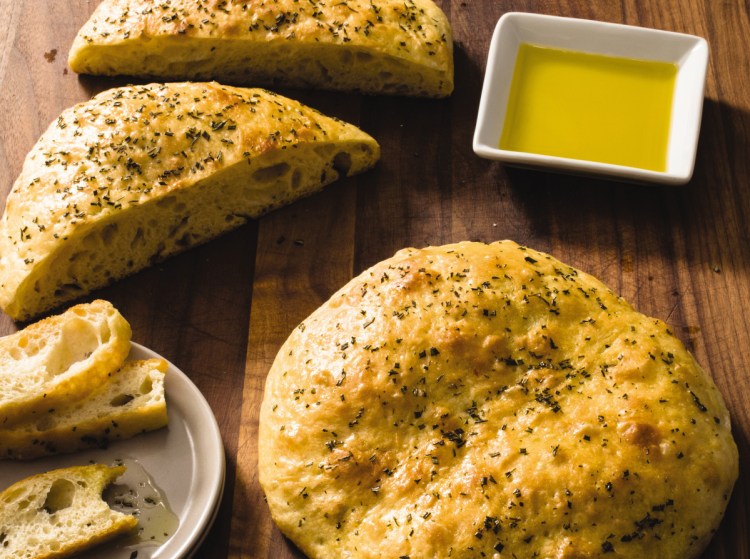Centuries ago, focaccia began as a byproduct: When bakers needed to gauge the heat of the wood-fired oven – focaccia stems from focolare and means “fireplace” – they would tear off a swatch of dough, flatten it, drizzle it with olive oil, and pop it into the hearth to bake as an edible oven thermometer.
From there evolved countless variations on the theme – the stuffed pizza-like focaccia in Puglia and Calabria, the ring-shaped focaccia in Naples, and even sweet versions. That said, it’s the dimpled, chewy, herb-topped deep-dish focaccia alla genovese that’s most fundamental.
As is traditional, our recipe starts with a sponge – a mixture of flour, yeast, and water that ferments for at least 6 hours before it’s added to the bulk dough. The sponge helped develop gluten (which gives breads structure and chew), depth of flavor, and a hint of tang.
Rather than knead the dough, we simply used a series of gentle folds, which developed the gluten structure further while also incorporating air for a tender interior crumb.
ROSEMARY FOCACCIA
Serves: 12-16 (Makes two 9-inch round loaves)
SPONGE:
1/2 cup (2 1/2 ounces) all-purpose flour
1/3 cup water, room temperature
1/4 teaspoon instant or rapid-rise yeast
DOUGH:
2-1/2 cups (12-1/2 ounces) all-purpose flour
1-1/4 cups water, room temperature
1 teaspoon instant or rapid-rise yeast
Kosher salt
1/4 cup extra-virgin olive oil
2 tablespoons chopped fresh rosemary
FOR THE SPONGE: Stir all ingredients in large bowl with wooden spoon until well combined. Cover tightly with plastic wrap and let sit at room temperature until sponge has risen and begins to collapse, about 6 hours (sponge can sit at room temperature for up to 24 hours).
FOR THE DOUGH: Stir flour, water, and yeast into sponge with wooden spoon until well combined. Cover bowl tightly with plastic and let dough rest for 15 minutes.
Stir 2 teaspoons salt into dough with wooden spoon until thoroughly incorporated, about 1 minute. Cover bowl tightly with plastic and let dough rest for 30 minutes.
Using greased bowl scraper (or rubber spatula), fold dough over itself by gently lifting and folding edge of dough toward middle. Turn bowl 45 degrees and fold dough again; repeat turning bowl and folding dough 6 more times (total of 8 folds). Cover tightly with plastic and let rise for 30 minutes. Repeat folding and rising. Fold dough again, then cover bowl tightly with plastic and let dough rise until nearly doubled in size, 30 minutes to 1 hour.
One hour before baking, adjust oven rack to upper-middle position, place baking stone on rack, and heat oven to 500 F. Coat two 9-inch round cake pans with 2 tablespoons oil each. Sprinkle each pan with 1/2 teaspoon salt. Transfer dough to lightly floured counter and dust top with flour. Divide dough in half and cover loosely with greased plastic. Working with 1 piece of dough at a time (keep remaining piece covered), shape into 5-inch round by gently tucking under edges.
Place dough rounds seam side up in prepared pans, coat bottoms and sides with oil, then flip rounds over. Cover loosely with greased plastic and let dough rest for 5 minutes.
Using your fingertips, gently press each dough round into corners of pan, taking care not to tear dough. (If dough resists stretching, let it relax for 5 to 10 minutes before trying to stretch it again.) Using fork, poke surface of dough 25 to 30 times, popping any large bubbles. Sprinkle 1 tablespoon rosemary evenly over top of each loaf, cover loosely with greased plastic, and let dough rest until slightly bubbly, about 10 minutes.
Place pans on baking stone and reduce oven temperature to 450 F. Bake until tops are golden brown, 25 to 30 minutes, rotating pans halfway through baking. Let loaves cool in pans for 5 minutes. Remove loaves from pans and transfer to wire rack. Brush tops with any oil remaining in pans and let cool for 30 minutes. Serve warm or at room temperature.
Send questions/comments to the editors.



Comments are no longer available on this story